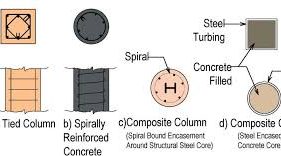Columns are key structural elements in building construction that support and stabilize the overall structure. They transfer the load from the upper floors to the foundation, ensuring the building’s strength and integrity. This comprehensive guide explores various types of columns commonly used in building construction. From classical architectural styles to modern structural designs, understanding the different types of columns is crucial for architects, engineers, and construction professionals.
Doric Columns
Doric columns are one of the oldest and most prominent column types in classical architecture. They are characterized by their simplicity and strength. Doric columns have a fluted shaft with no base and a plain, cushion-like capital. They often feature a simple, square abacus. Doric columns are commonly found in ancient Greek and Roman temples and classical architectural styles.
Ionic Columns
Ionic columns are known for their elegance and decorative elements. They have a slender, fluted shaft and a distinctive capital with two scrolling volutes. The volutes are connected by an echinus, a curved molding. Ionic columns often feature a decorative base. This column type is frequently used in classical architecture, particularly in buildings that require a more decorative and sophisticated appearance.
Corinthian Columns
Corinthian columns recognize for their ornate and elaborate design. They have a slender, fluted shaft, a capital adorned with acanthus leaves, and a decorative base. The Corinthian capital is intricately design with intricate foliage and scrolls. This column type is often associated with grand, luxurious buildings and is considered the most decorative of the classical orders.
Composite Columns
Composite columns combine elements of both Ionic and Corinthian columns. They have a fluted shaft and a capital that combines the volutes of the Ionic order with the acanthus leaves of the Corinthian order. Composite columns offer a fusion of elegance and decoration. They are commonly use in Roman architecture and buildings influenced by classical styles.
Reinforced Concrete Columns
Reinforced concrete columns widely use in modern construction. They construct by reinforcing concrete with steel bars or mesh to enhance their strength and load-bearing capacity. Reinforced concrete columns offer versatility in design and can customiz to meet specific structural requirements. They commonly use in high-rise buildings, bridges, and other structures that require significant load-bearing capabilities.
Steel Columns
Steel columns favor for their strength, durability, and versatility. They made of structural steel sections, such as I-beams or H-columns, and can design in various sizes and shapes to accommodate different loads and architectural requirements. Steel columns offer excellent resistance to compression and are commonly use in commercial and industrial buildings, as well as in infrastructure projects like bridges.
Composite Columns
Composite columns are a combination of different materials, typically steel and concrete. The steel component provides strength and stiffness, while the concrete component provides additional resistance to fire and improves load distribution. Composite columns offer a balance between strength, durability, and fire resistance. They commonly use in high-rise buildings and structures that require both structural efficiency and fire safety.
Conclusion
Columns play a vital role in building construction, providing support and stability to the overall structure. From the timeless elegance of Doric, Ionic, and Corinthian columns to the modern versatility of reinforced concrete and steel columns, each type offers unique characteristics and benefits. By understanding the different types of columns and their architectural and structural features, professionals in the construction industry can design and construct buildings that are not only functional but also aesthetically pleasing and structurally sound.

